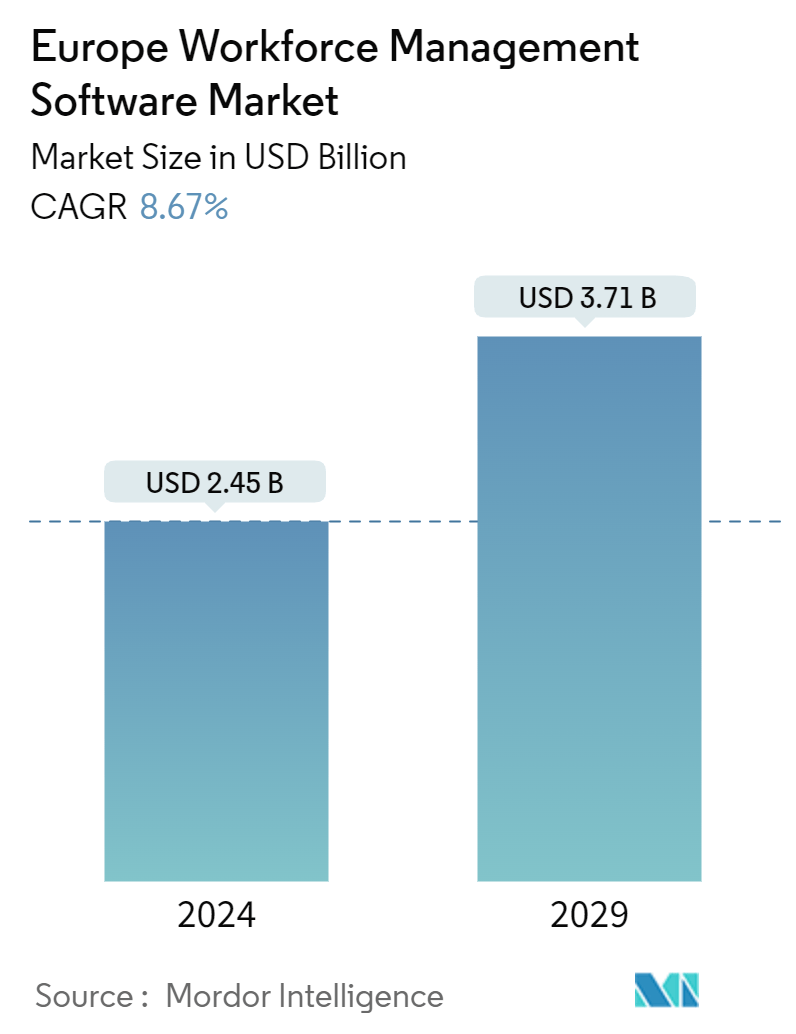Market Size of Europe Workforce Management Software Industry

| Study Period | 2019 - 2029 |
| Base Year For Estimation | 2023 |
| Market Size (2024) | USD 2.45 Billion |
| Market Size (2029) | USD 3.71 Billion |
| CAGR (2024 - 2029) | 8.67 % |
| Market Concentration | Low |
Major Players
*Disclaimer: Major Players sorted in no particular order |
Europe Workforce Management Software Market Analysis
The Europe Workforce Management Software Market size is estimated at USD 2.45 billion in 2024, and is expected to reach USD 3.71 billion by 2029, growing at a CAGR of 8.67% during the forecast period (2024-2029).
The growth is primarily driven by the need for improved productivity to maintain competitive advantage and the growing complexity of workforce-related standards, making it imperative for firms to rely on IT solutions to ensure compliance.
- Given the evolving workplace nature, managing the workforce by maintaining spreadsheets and registers for all activities became highly time-consuming, cumbersome, and prone to errors. Workforce management software is essential in optimizing organizational performance by enabling effective administration of work schedules, business processes, labor costs, and talent management. Embedded with analytics and drill-down features for the data, it provides even deeper insights for better human capital management.
- The trend toward remote work is steadily growing for the past decade. However, the COVID-19 effect dramatically accelerated this trend in a brief period, forcing companies, irrespective of their size, to adapt quickly to the self-isolation measures that governments across the region were recommending. With the pandemic requiring more people to work remotely, remote workforce management software became essential for companies, as this software can help manage the remote workforce efficiently.
- Various companies offer workforce management solutions through the private cloud to provide multi-level physical and logical security features. One of the primary reasons for the inclination of many business leaders toward cloud-based workforce management is the desire to get in one solution. It may include services like salesforce, inbound marketing software, marketing automation software, workforce management software, and business analytical tools to achieve insights into commercial, operational, and financial aspects.
- Most software-as-a-service evaluations focus on measuring feature sets against any current problem areas and finding a vendor to work well. However, implementing new workforce management software can be an expensive and time-consuming process, one that needs to be performed right to reap the benefits that any organization seeks.
Europe Workforce Management Software Industry Segmentation
Workforce management software enables organizations to centralize human capital and resource usage data and better plan future utilization through demand forecasting and schedule resource utilization. To manage several workforce aspects for better productivity, the market solutions include workforce forecast and scheduling, time and attendance management, performance management, and absence and leave management, among other software. Different organizations adopt deployment modes in various end-user verticals in the European region.
The Europe workforce management software market is segmented by deployment mode (on-premises, cloud), size of the organization (small and medium enterprises, large enterprises), type (workforce scheduling and workforce analytics, time and attendance management, performance and goal management, absence and leave management, and other software (fatigue management, task management, and others)), end-user vertical (healthcare, BFSI, manufacturing, consumer goods, and retail, and other end-user industries) and geography (UK, France, Germany, Spain, Benelux, and rest of Europe). The market sizes and forecasts are in terms of value (USD) for all the above segments.
| By Deployment Mode | |
| On-premise | |
| Cloud |
| By Size of Organization | |
| Small and Medium Enterprises | |
| Large Enterprises |
| By Type | |
| Workforce Scheduling and Workforce Analytics | |
| Time and Attendance Management | |
| Performance and Goal Management | |
| Absence and Leave Management | |
| Other Software (Fatigue Management, Task Management, etc) |
| By End-user Industry | |
| Healthcare | |
| BFSI | |
| Manufacturing | |
| Consumer Goods and Retail | |
| Other End-user Industries |
| By Country | |
| United Kingdom | |
| France | |
| Germany | |
| Spain | |
| Benelux | |
| Rest of Europe |
Europe Workforce Management Software Market Size Summary
The European workforce management software market is poised for significant growth, driven by the increasing need for organizations to enhance productivity and comply with complex workforce-related standards. As businesses move away from traditional methods like spreadsheets and registers, the adoption of workforce management software becomes crucial for optimizing performance through effective scheduling, process management, and talent oversight. The rise of remote work, accelerated by the COVID-19 pandemic, has further underscored the importance of these solutions, as companies require robust tools to manage distributed teams efficiently. The trend towards cloud-based solutions is gaining traction, offering integrated services that encompass various business functions, from marketing automation to analytics, all aimed at improving operational and financial insights.
In the UK, the demand for workforce management software is fueled by the need for flexibility and adaptability in a rapidly expanding private sector. Sectors such as manufacturing, travel, transport, and retail are leading the charge in adopting these systems to enhance productivity and streamline operations. The shift to remote work has also spurred investment in cloud services, with significant funding directed towards digital transformation in healthcare. The competitive landscape in Europe is dynamic, with numerous players innovating to meet the evolving needs of end-user industries. Recent acquisitions and the introduction of new solutions, such as those by SD Worx and Calabrio, highlight the market's growth potential and the ongoing efforts to enhance workforce management capabilities across the region.
Europe Workforce Management Software Market Size - Table of Contents
-
1. MARKET INSIGHTS
-
1.1 Market Overview
-
1.2 Industry Attractiveness - Porter's Five Forces Analysis
-
1.2.1 Bargaining Power of Suppliers
-
1.2.2 Bargaining Power of Buyers/Consumers
-
1.2.3 Threat of New Entrants
-
1.2.4 Threat of Substitute Products
-
1.2.5 Intensity of Competitive Rivalry
-
-
1.3 Assessment of the COVID-19 Impact on the Market
-
-
2. MARKET SEGMENTATION
-
2.1 By Deployment Mode
-
2.1.1 On-premise
-
2.1.2 Cloud
-
-
2.2 By Size of Organization
-
2.2.1 Small and Medium Enterprises
-
2.2.2 Large Enterprises
-
-
2.3 By Type
-
2.3.1 Workforce Scheduling and Workforce Analytics
-
2.3.2 Time and Attendance Management
-
2.3.3 Performance and Goal Management
-
2.3.4 Absence and Leave Management
-
2.3.5 Other Software (Fatigue Management, Task Management, etc)
-
-
2.4 By End-user Industry
-
2.4.1 Healthcare
-
2.4.2 BFSI
-
2.4.3 Manufacturing
-
2.4.4 Consumer Goods and Retail
-
2.4.5 Other End-user Industries
-
-
2.5 By Country
-
2.5.1 United Kingdom
-
2.5.2 France
-
2.5.3 Germany
-
2.5.4 Spain
-
2.5.5 Benelux
-
2.5.6 Rest of Europe
-
-
Europe Workforce Management Software Market Size FAQs
How big is the Europe Workforce Management Software Market?
The Europe Workforce Management Software Market size is expected to reach USD 2.45 billion in 2024 and grow at a CAGR of 8.67% to reach USD 3.71 billion by 2029.
What is the current Europe Workforce Management Software Market size?
In 2024, the Europe Workforce Management Software Market size is expected to reach USD 2.45 billion.

